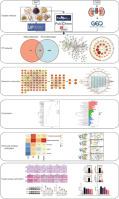Phytomedicine ( IF 6.7 ) Pub Date : 2023-05-13 , DOI: 10.1016/j.phymed.2023.154873 Run Li 1 , Chunru Shi 1 , Cuiting Wei 1 , Chao Wang 1 , Hongjian Du 2 , Ran Liu 2 , Xu Wang 2 , Quan Hong 2 , Xiangmei Chen 1

|
Background
Fufang Shenhua tablet (SHT), a traditional Chinese medicine compound, has been utilized in the clinical management of chronic kidney disease (CKD) for a long time. Nevertheless, the fundamental active constituents and potential mechanism of action remain unclear. Thus, the objective of this study was to investigate the renoprotective effect of SHT on residual renal tissue in CKD model rats and to explore its primary efficacious components and their underlying mechanism.
Methods
After a 12-week period of SHT treatment through gavage in a 5/6 nephrectomized animal model of CKD, we evaluated the body weight, renal function, and renal pathological changes. Furthermore, the expression levels of fibronectin (FN), collagen I (COL-1), α-smooth muscle actin (α-SMA), and vimentin in renal tissues were assessed. In addition, network pharmacology analysis and molecular docking were utilized to predict the primary active components, potential therapeutic targets, and intervention pathways through which SHT could potentially exert its anti-kidney fibrosis effects. Subsequently, these predictions were validated in renal tissues of rats with CKD and in transforming growth factor β1 (TGF-β1)-induced HK-2 cells.
Results
SHT significantly improved renal function and reduced renal pathological damage and fibrosis in CKD model rats. Network pharmacological analysis identified 62 active components in SHT, with quercetin ranked first, and 105 protein targets shared by SHT and CKD. Based on the protein‒protein interaction network (PPI) and the SHT-CKD-pathway network, AKT1, MYC, IL2, and VEGFA were identified as key targets. Furthermore, GO and KEGG pathway enrichment analyses indicated that the renoprotective effect of SHT on CKD was closely associated with the PI3K/AKT signaling pathway. Molecular docking results demonstrated that the main active components of SHT had a strong binding affinity to the hub genes. During experimental validation, SHT hindered the activity of the PI3K/AKT signaling pathway in the renal tissue of CKD model rats. Furthermore, activation of the PI3K/AKT signaling pathway was correlated with a modified fibrotic phenotype in rats with 5/6 nephrectomy-induced CKD and TGF-β1-induced HK-2 cells. Conversely, SHT and quercetin curtailed the activation of the PI3K/AKT signaling pathway and inhibited the formation of renal fibrosis, thus indicating that the PI3K/AKT signaling pathway is the basis of the antifibrotic effects of SHT. Ultimately, administration of the PI3K/AKT agonist 740Y-P counteracted the fibrotic phenotype of TGF-β1-induced HK-2 cells induced by SHT.
Conclusions
In this investigation, we employed a fusion of systems pharmacology and in vivo and in vitro experiments to elucidate the mechanism of SHT's antifibrotic properties via obstruction of the PI3K/AKT signaling pathway. Additionally, we surmised that AKT may be the principal target of SHT for the management of CKD and that quercetin may be its efficacious component. We have thus identified SHT as a promising drug for the amelioration of renal fibrosis and the progression of CKD.
中文翻译:

复方肾花片通过抑制PI3K/AKT抑制肾纤维化
背景
复方肾花片 (SHT) 是一种中药复方,长期以来一直用于慢性肾脏病 (CKD) 的临床治疗。然而,基本的活性成分和潜在的作用机制仍不清楚。因此,本研究的目的是探讨SHT对CKD模型大鼠残余肾组织的肾脏保护作用,并探讨其主要有效成分及其作用机制。
方法
在 5/6 肾切除的 CKD 动物模型中通过强饲法进行为期 12 周的 SHT 治疗后,我们评估了体重、肾功能和肾脏病理变化。此外,还评估了肾组织中纤连蛋白 (FN)、胶原蛋白 I (COL-1)、α-平滑肌肌动蛋白 (α-SMA) 和波形蛋白的表达水平。此外,利用网络药理学分析和分子对接预测了SHT可能发挥其抗肾纤维化作用的主要活性成分、潜在治疗靶点和干预途径。随后,这些预测在 CKD 大鼠的肾组织和转化生长因子 β1 (TGF-β1) 诱导的 HK-2 细胞中得到验证。
结果
SHT显着改善了CKD模型大鼠的肾功能,减轻了肾脏病理损伤和纤维化。网络药理学分析确定了 SHT 中的 62 种活性成分,槲皮素排名第一,SHT 和 CKD 共有 105 个蛋白质靶点。基于蛋白质-蛋白质相互作用网络 (PPI) 和 SHT-CKD 通路网络,AKT1、MYC、IL2 和 VEGFA 被确定为关键靶点。此外,GO 和 KEGG 通路富集分析表明,SHT 对 CKD 的肾脏保护作用与 PI3K/AKT 信号通路密切相关。分子对接结果表明,SHT的主要活性成分与hub基因具有很强的结合亲和力。在实验验证期间,SHT 阻碍了 CKD 模型大鼠肾组织中 PI3K/AKT 信号通路的活性。此外,PI3K/AKT 信号通路的激活与 5/6 肾切除术诱导的 CKD 和 TGF-β1 诱导的 HK-2 细胞的大鼠的改良纤维化表型相关。相反,SHT 和槲皮素减少了 PI3K/AKT 信号通路的激活并抑制了肾纤维化的形成,因此表明 PI3K/AKT 信号通路是 SHT 抗纤维化作用的基础。最终,施用 PI3K/AKT 激动剂 740Y-P 抵消了 SHT 诱导的 TGF-β1 诱导的 HK-2 细胞的纤维化表型。因此表明 PI3K/AKT 信号通路是 SHT 抗纤维化作用的基础。最终,施用 PI3K/AKT 激动剂 740Y-P 抵消了 SHT 诱导的 TGF-β1 诱导的 HK-2 细胞的纤维化表型。因此表明 PI3K/AKT 信号通路是 SHT 抗纤维化作用的基础。最终,施用 PI3K/AKT 激动剂 740Y-P 抵消了 SHT 诱导的 TGF-β1 诱导的 HK-2 细胞的纤维化表型。
结论
在这项研究中,我们采用了系统药理学与体内和体外实验的融合,通过阻断 PI3K/AKT 信号通路阐明 SHT 抗纤维化特性的机制。此外,我们推测 AKT 可能是 SHT 治疗 CKD 的主要靶点,而槲皮素可能是其有效成分。因此,我们已将 SHT 确定为一种有前途的药物,用于改善肾纤维化和 CKD 的进展。











































 京公网安备 11010802027423号
京公网安备 11010802027423号